Sallim
2009
Powder-coated steel frame, powder-coated perforated metal plates, casters, aluminum venetian blinds, knitting yarn, acrylic mirror, IV stand, light bulbs, cable, zip ties, terminal strips, metal rings, metal chains, fan, timer, dried garlic, plates, hot pad, scent emitters
310 x 250 x 420 cm
Collection of The Museum of Modern Art, New York, Fund for the Twenty-First Century and gift of Agnes Gund, Glenn Fuhrman, and Jerry I. Speyer, 2010
Installation view of Condensation, Korean Pavilion, 53rd Venice Biennale, Venice, 2009
Photos: Pattara Chanruechachai

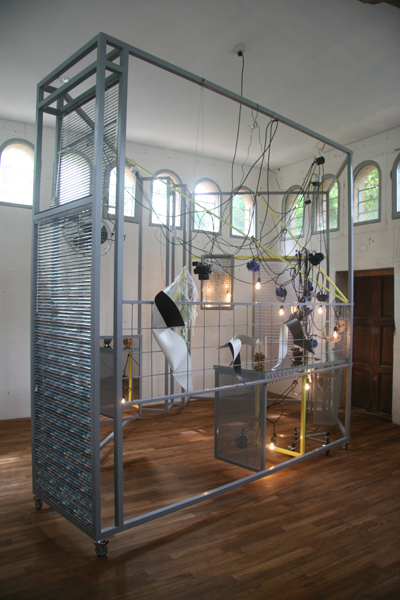
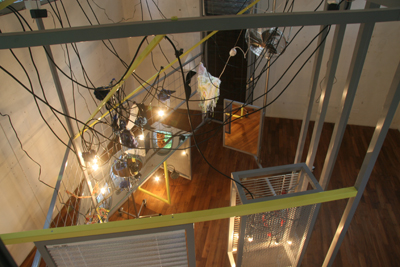
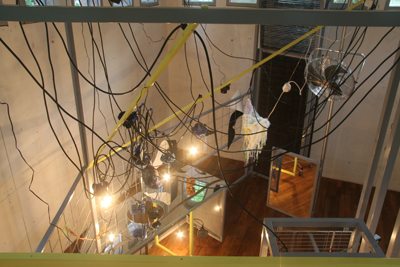
Installation view of Scenes for a New Heritage: Contemporary Art from the Collection, The Museum of Modern Art, New York, USA, 2015
Photo: Kukje Gallery
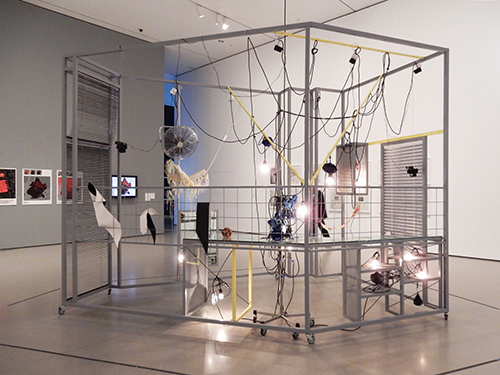
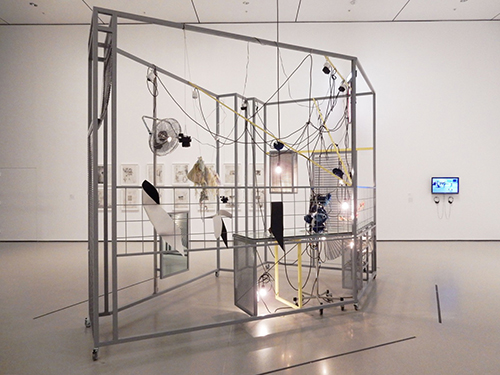

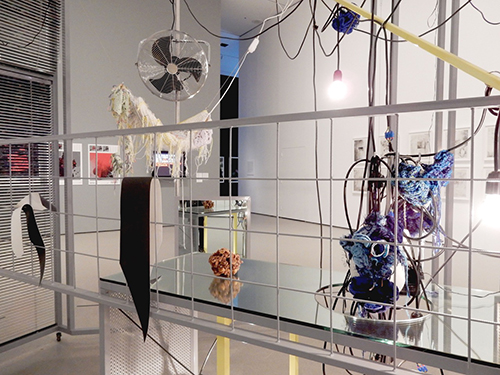
Installation view of Emergence, Art Gallery of Ontario, Toronto, Canada, 2020
Photo: Craig Boyko
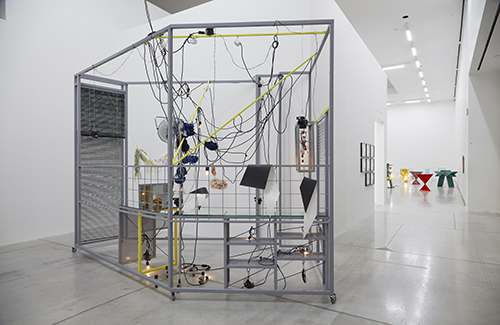
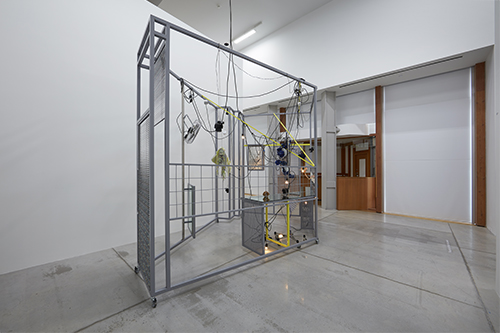

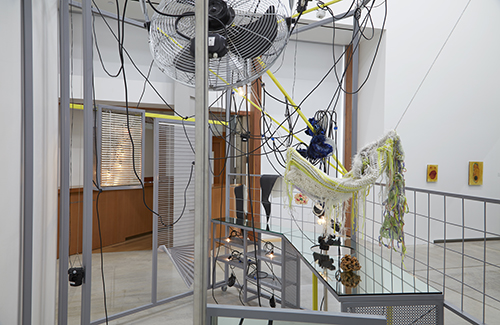
Related Texts
Excerpt from the press release of Condensation, Korean Pavilion, 53rd Venice Biennale, Venice, 2009.
In the sculpture Sallim (2009), Yang reproduces a full-scale model of her Berlin kitchen. Sallim (roughly translated as “running a household”) considers the noncommercial space of the kitchen as a site of preparation for action and the organization of life. Indebted to works such as Martha Rosler’s Semiotics of the Kitchen (1975) and other feminist practices of the 1960s and 1970s that insisted on the undervalued labor and potential of “women’s work,” Sallim unearths a potentially radical value in the domestic sphere of the kitchen as a space of “worklessness.” Yang’s kitchen is, as she says, “free from many of the things that are attributes of the ordinary concept of work in terms of social effectiveness/productivity,” thereby nurturing a different connection to the outside world, to others, and to her work.
Excerpt from From One To Many: Emergence in the Work of Haegue Yang by Adelina Vlas, published in Haegue Yang: Emergence, AGO, Toronto and DelMonico Books Prestel Verlag, Munich, London and New York, 2021.
In 2009, Yang represented South Korea in the Venice Biennale with a solo exhibition in the national pavilion. One of the three works included in this presentation was Sallim (2009), an architectural sculpture on casters modelled on the kitchen of her Berlin home and studio, preserving the shape, scale, and spirit of the original space. Sallim evokes a domestic kitchen by way of scent emitters that generate smells associated with food preparation and digestion (Curry, Freshly Brewed Coffee, French Bread, Hot Apple Pie, Vomit, Dinosaur Dung, etc.). In Korean, the word “sallim” means “running a household.” In the context of this sculpture, however, the term is more expansive—Yang also engages with the private aspects of an artist’s life, such as thinking, resting, and cooking; activities that, when deployed with purpose, can be radical in themselves. The artwork was partly inspired by the real-life experiences of two influential figures for Yang: her mother and Duras. Both harboured and fed political dissidents in their homes, transforming their kitchens into unexpected symbols of resistance against sociopolitical injustice. With these references to her personal touchstones, Yang reimagines quiet, domestic activities as powerful public statements. Various aspects of her own personal history merge to create a narrative around the work. At the same time, the encounter with Sallim is meant to activate individual memories through its constituent sensorial elements: light, air, heat, and scent. They stimulate our senses to generate associations that are unique to each participant; our own memories and biographies emerge in response to the work.
Excerpt from Haegue Yang: Performing Identity, Crafting an Aesthetic by Lynne Cooke, published in Haegue Yang: Emergence, AGO, Toronto and DelMonico Books Prestel Verlag, Munich, London and New York, 2021.
The tropes of nomadism and exile, estrangement and dislocation that shape the discursive register in Yang’s practice have tended to overshadow critical recognition of the artist’s growing preoccupation with issues involving domesticity, craft, and the politics of labour. Sallim (2009), created three years after the foundational Sadong 30, represents a milestone in the resetting of these topics. It is one of a few works that Yang has given a title in her native tongue (for the most part, she uses English or French). Etymologically, the word “Sallim” refers to “life organization,” as well as to notions of the household and homemaking. Formally, the sculpture comprises a framing metal structure that replicates (to scale) the volume and footprint of the kitchen in the Berlin apartment where the artist was living when she made the piece. The “room” is furnished with a range of appliances (including a radiator and a sink), which have also been schematically rendered, as well as a selection of culinary items (such as crockery) and sensory devices (notably, dried garlic cloves, hot pads and scent emitters). Several hand-knit woollen textiles, at variance with this vocabulary of manufactured artifacts, are also included. Doryun Chong, a curator and long-time friend of the artist, underscored the unique place that Sallim occupies in her oeuvre. As he put it, “Yang’s understanding of ‘community,’ in one sense, revolves intimately around her assistants and collaborators. The domestic kitchen has become inseparable from the studio. The lines between work and non-work has [sic] become blurred, and intimacy normally reserved for the self and non-working relationships is distributed through domesticity.”[12] If Yang is communicating a sense of community through Sallim, as Chong persuasively argues, then the terms she uses to express this concept are radically different from those that constitute the “community-in-absence” emblematic of her site-related works, with their abstracted spatial and temporal registers.
[12] Doryun Chong, “A Less Small Dictionary (for HY),” in Haegue Yang: Family of Equivocations, ed. Camille Giertler and Liz Braat (Strasbourg: Musées de Strasbourg, 2013), 6.
Exhibition history
Condensation, 53rd Venice Biennale, Korean Pavilion, Venice, 2009
Scenes for a New Heritage: Contemporary Art from the Collection, The Museum of Modern Art, New York, USA, 2015
Emergence, Art Gallery of Ontario, Toronto, Canada, 2020
Illusions of Life, The Museum of Modern Art, New York, USA, 2024
back to alphabetical order |
back to chronological order |